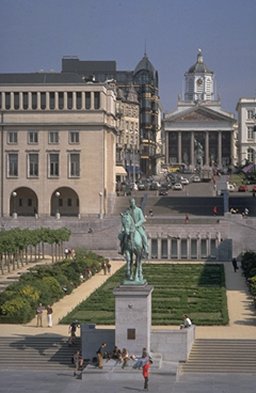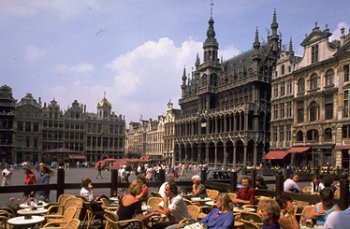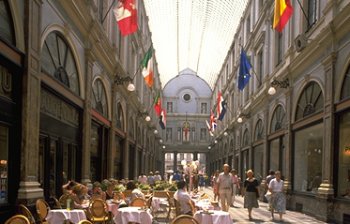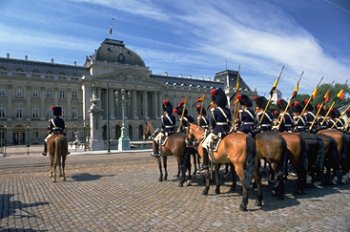|
|
| |
BELGIUM
BRUSSELS
The capital of Flanders is Brussel, which is also the Capital of Europe and the Kingdom of Belgium. The monarchy has left an indelible mark on the city, with many remarkable monuments, parks and palaces. Brussel is also a metropolis full of music, classical or modern, pop or jazz. In Brussel, you can get to know the "Brusselaars", engaging and hospitable people with a warm heart and with a special form of humour. In Brussel, a hint of surrealism is never far away.

The Kunstberg
Author: W. Simoens
Copyright © Toerisme Vlaanderen
A city of four quarters
The many facets of Brussel are expressed in the four quarters of the city, which are a must for every visitor. First of all, there is the Lower Town, which extends from Manneken Pis via the Grand Place to the Botanique. The Royal District in the Upper Town occupies the area between the Warande and the Palace of Justice. In the North of the City lies the Heizel with the Atomium and Bruparck. Just outside the city centre you will find the Cinquantenaire park and the European District.
Grand Place
The pride of the Lower Town and of Brussel is the unique Grand Place. After a bombardment in 1695, where only the city hall remained standing, work started on rebuilding one of the finest squares in the world. The buildings around it each have a specific frontage, but they are all in complete harmony with each other.
The City Hall, founded in the 15th century, is the finest building in the city. Above the 97 m high tower is the recently restored image of St. Michael, the patron saint of Brussel. Innumerable mementoes of the illustrious past of this great city are displayed in the sumptuous rooms of the city hall.
 Grand'Place
Author: D. de Kievith
Copyright © Toerisme Vlaanderen
The Museum of the City of Brussel is housed in the Broodhuis. You can admire early paintings by Breugel, as well as the entire wardrobe of Manneken Pis, Brussel' most famous citizen. In the Stoofstraat behind the city hall, you will find the statue of the little rascal, who has been pissing here since 1691.
To the north-east of the Grand Place, you will find the Sint-Hubertus gallery, built in 1846 and the oldest covered shopping arcade in Europe. Via this arcade with its shops, restaurants, cafés and 3 theatres, you reach the famous "Ilot Sacré", the gastronomic centre of the city.
The Martelaarsplein dates from the 18th century. A number of symmetrical buildings, recently restored, give this square a unique appearance. Behind one of the fine facades is the headquarters of the Flemish government.
 The Galleries Saint Hubert
Author: D. de Kievith
Copyright © Toerisme Vlaanderen
Nearby, in the Zandstraat, you will find the National Comic Strip Centre, better known as the Strip Museum. In this typical Art Nouveau house, you can see the work of over a hundred Belgian cartoon strip artists.
Royal District
One easy landmark to find in this district is the Cathedral of Saint Gudule and Saint Michael. The building of this majestic cathedral church started in the 13th century. The cathedral was completed in the 15th century The two complete towers are a striking feature, and are unusual for a Gothic church, and it has beautiful Renaissance leaded windows.
Via Treurenberg, you then reach the administrative district, built around the Warande, a completely symmetrical park. On the north side, lies the Parliament or Palace of the Nation, as well as the Flemish Parliament. Immediately opposite is the Royal Palace, with remarkable rooms which are open to the public for a few months each year. To the west is the Paleis voor Schone Kunsten where, among other things, the annual Queen Elisabeth Music Competition is held. Via the decorative Koningsplein, you reach the Royal Fine Arts Museums, with the Museum of Ancient Art (from the Flemish Primitives to Rubens and Van Dyck) and the Museum of Modern Art (with a substantial amount of work by Delvaux and Magritte).
A little further, you reach the Zavel, the antiques district of Brussel, with the Gothic Zavelkerk and leading to the Kapellekerk, where Pieter Bruegel is buried. The painter lived and worked in the Marolles, the Brussel working-class district par excellence, with the Vossenplein at its heart, where a daily bric-a-brac, antique and flea market takes place. The Marolles district is dominated by the imposing Palace of Justice, which is also the largest public building in Europe.
Heizel
On the Heizel plateau, in the district of Laken, stands the Atomium, representing an iron crystal molecule magnified 165 billion times. This unique construction dating from 1958 dominates the Exhibition Centre, where the huge annual exhibitions are organised, and the King Baudouin Stadium, where large sporting events are held. The Bruparck leisure complex consists of a subtropical swimming pool (Océade), cinemas (Kinepolis) and the Mini-Europa model village.
The Royal Palace, where the sovereign actually lives, is also situated in Laken, in 160 hectares of grounds. The Chinese Pavilion and Japanese Tower add an exotic touch to the area.

The Royal palace
Author: D. de Kievith
Copyright © Toerisme Vlaanderen
Cinquantenaire and European district
The headquarters of the European Commission and the European Council of Ministers is near the Schuman roundabout. The European Parliament is in the Leopoldwijk area.
The Triumphal Arch dominates the Cinquantenaire Park with the Royal Museum of Art and History, the Army Museum and Autoworld, the largest museum of old cars in the world. For the Museum of Natural Sciences, the most modern of its kind, you should go to the Waversesteenweg.
Brussel Ommegang
One of the top events in Brussel is the Ommegang. For further information about events in Brussel, click here.
Going out
Brussel has two main centres for going out, both areas where you can shop until you drop. Popular purchases are pralines, chocolate, lace, crystal, pewter and diamonds. The cinemas, discotheques and cafes are naturally grouped around these centres. In the Royal District, that is around the Louizapoort, Naamsepoort and Zavel. In the Lower Town, visit the boulevards and adjacent streets between the De Brouckèreplein and Beursplein. In both districts, you can enjoy the culinary delights of Brussel, which are among the best in the world.
Information is Copyright © Toerisme Vlaanderen
| |
|
Festivals & Events
Jan Van Eyck and the Mediterranean World
24 March - June
The first exhibition dedicated to early Netherlandisch painting and its influence on the Southern European art scene of its days looks at works commissioned from Jan Van Eyck and other Flemish Primitives working abroad. Major works from all over Europe will be brought together in one of the finest museums in Bruges.

Brussel jubel park
Author: d. de Kievith
© Toerisme Vlaanderen
The Brueghel Enterprise
22. March - 23. June 2002
The exhibition will bring together about forty paintings by this artist who is well-known for having made an abundant number of copies after the works by his father Pieter Bruegel the Elder. The exhibition aims to juxtapose different versions of the same composition and to study and analyse them with state-of-the-art laboratory techniques.
It will be the first time ever that such an important number of versions is gathered. The exhibition is designed around four themes, each of them centred on a reference work: Census in Bethlehem, Winter Landscape with Bird Trap, The Adoration of the Magi in the Snow and The Farmer’s Advocate.

Brugge lace-maker
Author: d. de Kievith
© Toerisme Vlaanderen
Adriaan Brouwer Beer Festival
Yearly festival on the market square of the beautiful town of Oudenaarde.
Tel: (32-55) 31-7251

Brussel Grand Place
Author: d. de Kievith
© Toerisme Vlaanderen
Jazz Brugge 2002
August - 15-18
De Werf's European Jazz Festival is to be held alternating with the Middelheim festival, i.e. every second year.
Its venue will be the newly built, for the Brugge 2002 festivities, concert centre, a modern building with the largest stage in Belgium and capacity of 1400 seats.
Its emphasis will be on European jazz and artists.
There will be 3 to 4 groups per day, concerts starting around 15h and ending at 23h.

Brugge scenic view
Author: d. de. Kievith
© Toerisme Vlaanderen
Diamon Museum - Antwerp
Where the entire process of diamond mining and processing can be viewed.. Antwerp is the very centre of the world's diamond industry. More than 70% of the world's diamonds are cut, polished and traded here.

Brussel procession
Author: A. Koprianov
© Toerisme Vlaanderen
The Royal Greenhouses
April 19 - May 5
The Royal Greenhouses in Laeken cover six acres of neo-classical rotundas, domes and galleries. Twenty full time gardeners tend the giant ferns, fruit-bearing banana trees, grottoes, glades and grassy vistas. Highlights include the Azalea House, the rotunda, a colony of birds and the orange trees. Walkways are filled with climbing geraniums and fuschias, whose blossoms form an overhead canopy. The visit ends with a short walk through the Royal Park.

Brussel Grand'Place flowers
Author: J. J. Soenen
© Toerisme Vlaanderen
The Abbey of Villers-la-Ville
The Cistercian Abbey dates back to the 12th century. In the 19th century, a large number of artists, painters and writers, such as Victor Hugo, were attracted by the beauty of the majestic ruins, which are still sometimes used as a dramatic setting for French drama and classical concerts.

Oostende Mercator
Author: d. de Kievith
© Toerisme Vlaanderen
|
|
|